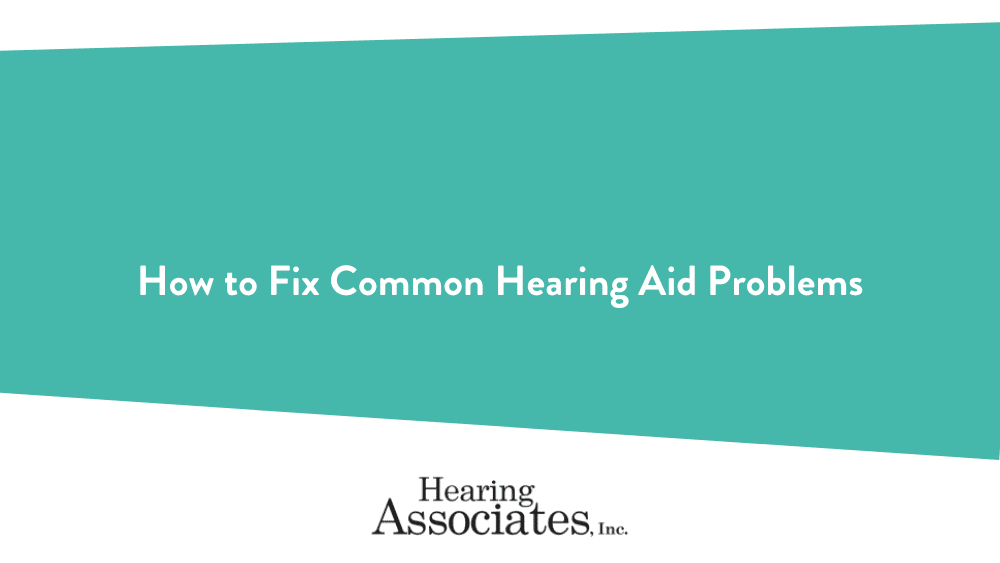Hearing aids are a widespread treatment for hearing loss and are used by many, many people. As with any device, issues can arise before or during their use, and they may be confusing or feel as though they are hard to fix.
On the contrary, many common problems patients have with hearing aids are easily fixed and can often be done at home without visiting your physician’s office.
In this article, I will be explaining some of the most common hearing aid problems I have seen among patients, and the steps to fix them! I hope that you find this information helpful, and with that information, find troubleshooting your hearing aid more approachable.
Problem #1: No Sound at All
- Make sure your hearing aid is turned on! This may seem obvious, but sometimes it can accidentally be turned off when putting it on, and sometimes we just forget! The most obvious solutions are usually the most overlooked.
- Make sure the volume is where it’s supposed to be. It’s also effortless to accidentally change the volume settings when putting your hearing aid(s) into your ear.
- If the power is on and the volume is set correctly, next check on the battery. Ensure that the battery is put in the right side up and that the cover is fully installed. If that seems OK, check to see if the battery needs to be charged or changed.
- If your hearing aid is still not working properly, you may need to look at the receiver tube for a blockage. If it is dirty or blocked, clean the tube.
- Lastly, check the microphone for dirt that may be preventing the sound from being picked up. If needed, clean the microphone of dust, dirt, and/or wax and test it again.
Problem #2: Sound is “funny” or Distorted
- Check to make sure your hearing aid was inserted properly. Try taking it out and putting it back in, and remember to keep your head straight ahead until the hearing aid is secured to ensure proper placement.
- Try a different size earpiece or a closed tip dome earpiece instead for a different and more secure fit.
- The whistling and feedback may also result from too much noise trying to get through the hearing aid, so try turning down the volume.
- Next, inspect your hearing aid for any cracks in the tubing or the ear hook. If this is the case, bring your device in, and we will replace the parts if needed.
- If you find that none of these steps work or the whistling persists, sometimes it could mean that earwax is blocking sound from traveling through your ear canal. Blockages should be assessed and cleared by a professional – don’t do this yourself!
Problem #3: Sound Isn’t Quite Right
- Double-check that your proper program and volume settings are still set to your hearing aid. If they were accidentally changed, reset them back to the correct settings. If you need assistance changing them or don’t remember your settings, we are here to help.
- Often wax, dirt, and lint can build up in the controls. To clear them out, you will need to rotate dials or switch any switches a few times to clear out any lingering debris. Just don’t forget to set them back to your specific settings before putting them back in!
- If the last step does not work, try thoroughly cleaning your hearing aid. Clear the tube, microphone, and earpiece of any wax, dust, lint, or any other debris that can collect and block the sound from reaching your inner ear.
- Next, check your battery and the contacts on either side of the battery terminal. These contacts and the battery can become corroded and may need to be replaced.
- If corrosion isn’t a problem, there may be moisture in your hearing aid. This can be solved using a drying kit or a dehumidifier that removes moisture overnight while you’re sleeping.
- If none of these troubleshooting steps, solve the problem, come in and visit one of our hearing aid experts!
Problem #4: The Fit isn’t Quite Right
- Have you dropped it at all? Even if it was a small fall that may have seemed insignificant, hearing aids are delicate devices and can be altered easily. If you have, do not try to fix it yourself. Wait until you can bring it to a trained professional to get fixed.
- Remember, fit can change over time! If you feel like something isn’t right, don’t hesitate to bring it into our office, and our staff will happily help you in any way we can.
Like I said earlier, hearing aids are incredibly complex pieces, and similarly to other advanced devices, things can certainly go wrong during use.
I hope that with this information, you may be able to troubleshoot most of the issues you may have. Still, at Hearing Associates, we also know that in some cases, fixing your device may be best left to the professionals.
When in doubt, give us a call or set up a virtual appointment, and we will most certainly be able to help you!

